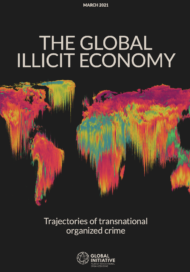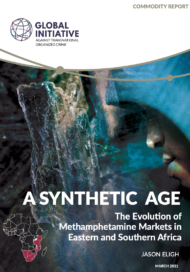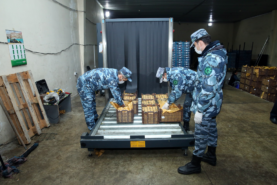Posted on 26 Aug 2021
Over the past weeks, the world has been watching the crisis in Afghanistan rapidly unfold, while commentators are reflecting on what the future may look like. A keen focus on the country’s illicit economies and their potential impacts on Afghanistan’s future political dynamics is now imperative.
The Taliban have taken control of government and most Afghan territory, and President Ashraf Ghani and other ministers have fled. Tens of thousands have risked their lives desperately trying to escape the new regime. Leaders of the Group of 7 nations convened on 24 August to discuss the situation.
Among the media coverage and policy analysis on Afghanistan, an often forgotten yet crucial issue is who will gain control of the illicit markets and financial flows that have formed and thrived in the country over the past 20 years. These have been critical to the Taliban’s financing – and may become more so as billions of dollars of foreign aid are withdrawn from the country.
Although the analysis tends to focus on drugs, in particular opium, sources of finance are much more diversified. Mineral resources and the smuggling of fuel and other licit goods also provide significant financial streams. Even the drug economy has diversified, with methamphetamine production seeing exponential growth. The question is what these illicit markets and flows will look like in the future, who will reap the profits and whether there will be competition for their control.
The interplay between the Taliban, local warlords and power brokers, and government actors has significantly influenced illicit markets, with alliances and competition for control shaping the size, form and direction of illicit markets and flows. Understanding their history is therefore critical to assessing these economies and comprehending the current complex and shifting criminal landscape.
The source of power for many Afghan power brokers today can be traced back to the creation of the mujahideen, regional warlords who allied to battle the communist regime and then the Soviet occupation of the 1980s. A coalition government was formed in 1992 after the mujahideen ousted the Soviet-backed government. However, infighting between various groups and high levels of corruption ensued.
Out of this chaos, the Taliban emerged in Kandahar and swept through southern Afghanistan in 1994, successfully attacking local warlords and gaining a reputation for military prowess. Two years later, the Taliban captured Kabul, and by 1998 the insurgents had taken control of the whole country except for a small portion in the north held by an alliance of warlords – the Northern Alliance. During this time, the Taliban banned poppy-opium production in the country, which was widely considered a success in reducing drug supply. In 2001, following the 11 September terrorist attacks, the US launched a military invasion of Afghanistan supporting the Northern Alliance and, by December, a new interim government had been formed.
Against this backdrop, there is a rural Afghan population largely reliant on subsistence livelihoods. Often, this means engaging in illicit activities such as poppy cultivation or informal work, like artisanal or small-scale mining. These entail paying taxes to whoever controls the territory and supply chains for the right to work or move goods. Powerful actors – be they the Taliban, power brokers or corrupt government officials – therefore exploit vulnerable populations and reap profits from both licit and illicit markets and supply chains.
A booming illicit economy
Although the Taliban is currently presenting itself as a cohesive force, it is not a heterogeneous organization. There are divisions in the organization’s political wing, which has been engaged in negotiations in Doha, and influential clergy figures and commanders. Control over the country’s illicit economies will depend on whether the organization fractures or stays united as a common movement.
Drug policy is one issue that may result in fragmentations within the Taliban, as promises to end the Afghan drug trade highlight underlying tensions. The Taliban wants to project a more moderate image as a governing entity, but any repression would hit farmers very hard, especially in the Taliban political heartlands of Helmand and Kandahar, in the south of the country. This would also be an economic blow for the organization: it is estimated that Taliban leaders have generated tens, if not hundreds of millions of dollars from controlling the poppy-growing regions, with farmers reporting they were pressured by warlords and Taliban fighters to plant poppies. An uneasy tension therefore between the group’s implementation of sharia law and its need to secure financing from illicit markets is also likely to play out.
In addition, foreign interventions by the US and other Western powers have had significant impacts on illicit markets and flows in Afghanistan for the past 20 years. In many cases, such intervention has not had the intended effect, and at times has fuelled corruption and criminal markets. The formation of partnerships with warlords and support for bringing them into government while turning a blind eye to criminal activity and extortion drove criminality and undermined government credibility. The Taliban provided services where the state failed to, increasing their legitimacy among some communities while further eroding the Afghan government.
The development of road infrastructure and banking systems also had direct effects on illicit markets and financial flows. Although these developments were critical to supporting the growth of trade and the economy, they were exploited by illicit actors of all types. Road infrastructure paved the way for easier access to and movement of illicit goods and the establishment of checkpoints to extort transport, while improved banking systems contributed to new forms of mass money laundering.
What next for Afghanistan?
To predict what illicit markets and flows may look like in a future under the Taliban, these dynamics and who may step into the void left by the American departure all need to be assessed. How will the Taliban and other remaining actors seek to survive and grow profit streams, as foreign investment and cash reserves quickly dry up?
There are several potential scenarios. In the first, given the wide territorial expanse and infrastructure the Taliban currently holds sway over, the organization will consolidate its control over the illicit markets, supporting their growth. However, this level of control will require coordination between the various factions of the Taliban, which may well prove unsustainable.
Another scenario is that the Taliban keeps its promise to end the drug trade and prevents Afghanistan from becoming a ‘narco-state’. If this approach to law and order were to extend to other markets, illicit economies could be significantly reduced in the country (aside from the argument that any financial flows to the Taliban, regarded as an extremist organization, could be considered illicit). However, such crackdowns would have a detrimental impact on farmers’ livelihoods and others who rely on illicit markets for survival. This risks undermining Taliban legitimacy within its heartland communities, which could result in increased resistance to the new regime.
Another possibility is that increasing competition for control of illicit markets over time may result in degeneration and factionalism within the Taliban and increased conflict with outside actors. When the Taliban swept to power in the 1990s, they not only defeated warlords but were also successful in co-opting and controlling them. History is repeating itself, with suspicions that agreements between the Taliban and local power brokers in recent weeks has enabled them to take territory at the speed they did. It remains to be seen whether the Taliban and regional power brokers will abide by these supposed accommodations, or whether conflict for control over illicit markets will ensue. We believe this final scenario, which has largely defined political economies and competition for illicit financial flows in the country, is the most likely outcome.
But whatever emerges under the new regime will certainly not be confined to Afghanistan. The Taliban takeover will have knock-on effects in the wider region. Pakistan is a key transit partner, not only for drug flows out of Afghanistan but also for precursor chemicals into Afghanistan, and mineral and migrant flows out of the country. There are also implications for heroin and methamphetamine flows from Afghanistan to Iran, central Asian neighbours and countries further down the drug route. The new regime is also expected to have a global impact on heroin prices, with repercussions for Western consumer markets, as well as for Russia, Iran, Pakistan and China – all present in major smuggling routes and huge markets for Afghan drugs.
The important message – one that is applicable not only to Afghanistan but also to other countries facing insecurity and transition – is that there must be efforts to address corruption and the illicit economy at the core of any engagement, given their proven ability to erode the foundations of stability, peace and democracy.
Looking to the future, any international support or engagement in Afghanistan will therefore need to be predicated upon a strong understanding of the criminal economy and how illicit flows are linked to the political economy of the country. This is a message that should not be lost among the current avalanche of commentary and policy analysis taking place. An understanding of the history and evolution of Afghanistan’s illicit markets is necessary to best predict how they will evolve in the future and how best to respond.
A forthcoming report by the Global Initiative Against Transnational Organized Crime focuses on the evolution of illicit markets in Afghanistan over the past 20 years, including the formation and dynamics of political economies and the impacts of foreign intervention.



